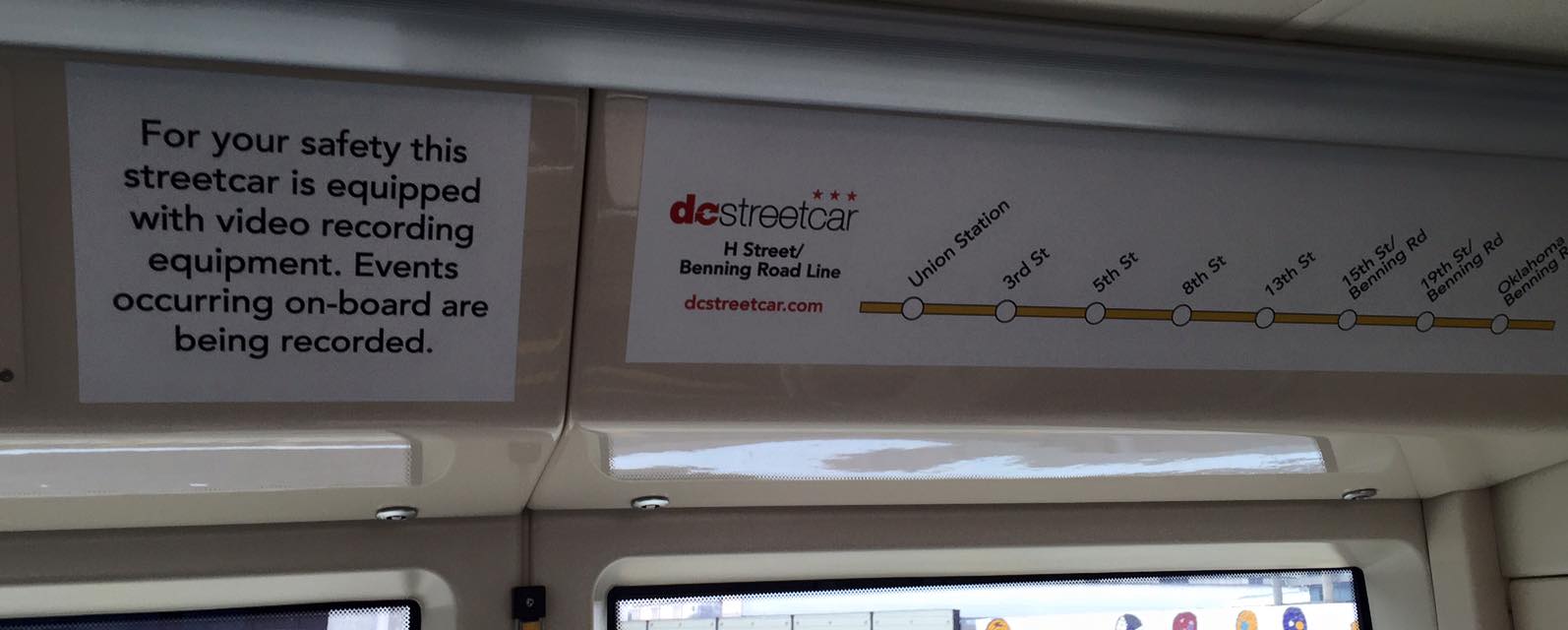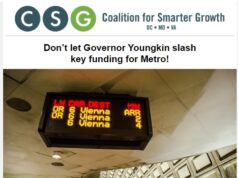 The other day, former Arlington County Board Democratic candidate Peter Fallon checked out the new D.C. streetcar, and had some thoughts. According to Fallon, there were pluses and minuses:
The other day, former Arlington County Board Democratic candidate Peter Fallon checked out the new D.C. streetcar, and had some thoughts. According to Fallon, there were pluses and minuses:
It’s shiny, new, and cool.
It’s free for the next six months.
It’s ADA accessible, though the stations aren’t always easy to get to. I found this to be the case using a stroller.
The stations are slightly elevated, so you board level to the tram. The doors are wide so it’s easy to board and alight the tram.
Conversely, unlike a Metro train, the inside of the tram has two levels. Moving from one level to another would be difficult if it was crowded.
There are “greeters” on board to answer questions and solicit feedback.
We rode the full line and back (Union Station to Benning Road Metro).
I felt safe aboard the tram. If a car had T-boned the tram, we’d probably have been unhurt. There was a sign saying the interior was under camera surveillance. I don’t know if this is the case on Metro trains.
The kids had a blast and wanted to stay on the tram.
The Union Station terminus is not easy to find if you’re actually inside Union Station. It’s not near the Metro station either. It’s basically behind the parking garage, so you walk through the parking garage to get to it. If they extended the line another block or two, you would probably be able to see the tram as you exit the Metro station. Long term, maybe add a new portal exit to serve the NoMa side and improve access to the streetcar. Right now, it’s not a seamless transition between streetcar to Metro or Amtrak.
It’s loud. The white noise from the hvac deadens the noise, but it’s still loud. If you’re on the street, the sound dissipates as the tram passes. If you’re on the tram, you can hold a conversation with the person next to you. Adding more soundproofing to the trams would be a good investment in rider comfort. On the other hand, the route is straight, so you don’t hear the metal on metal screech like when riding in a Metro tunnel.
The ride is “hard.” This is NOT like riding a Metro train. Actually, a bus may have a smoother ride on good pavement. Again, it wood be worth investing in a better suspension system to improve rider comfort.
The DC streetcar has very few seats (maybe 30). Let’s face it, everyone really prefers to get a seat versus stand for 3 miles. The Metrobuses have many more seats. Trams could be fitted with more seating.
It’s slow. Really slow. Every other car, bus or truck on H St passed us. In fact, at one point 4 Metrobuses in a row passed us.
The power supply wires aren’t pretty. They will never add charm to the streetscape. However, they are required to power this streetcar, so after a while you just have to accept it and learn to live with it. This assumes you don’t live on the second or third floor of one if the new $$$$ apartments and have these wires a few feet away. I understand the old DC streetcars had an underground power connection. If you’re tearing up the streets to lay tracks, may as well underground the power source too in my book.
The “stations” are very basic. I’m talking a bench for two people and no shelter from the weather. There is a counter with the minutes until the next tram. This is not a million dollar design. It is very unpleasant if you are standing in the median and traffic is speeding past. I know, we did this and I kept pulling the kids close to me.
The H St line runs along the curb and in the center, depending on where you are along the route. The crossover points take a while and confuse autos. The tram has to wait for the intersection to clear (this appears to be managed by traffic signals) before it can cross lanes. I don’t know why they did it this way, but I think it makes more sense to keep the tram in one lane.
There are a lot of buses on H St. They are full of passengers. The streetcars were mostly empty. Glancing around I’d garner that our fellow riders were playing tourist too. The current streetcar doesn’t sync up with Metro stations, while the busses do. Transit service needs to be integrated. For some reason DC’s streetcar assumes riders don’t mind walking 5-10 minutes to transfer between modes. This was either a design flaw, or they were eager to kick off service for political reasons and couldn’t make the integration work now.
We did not get stuck behind a broken streetcar. We did have to wait while cars ahead parallel parked. Eliminating parking in H St would deal with this, plus a wider sidewalk could include trees, benches, and cafes in good weather. They could even add a bike lane into the mix.
We also had to wait behind buses that were boarding passengers. It takes a while for people to board a bus. Interestingly, buses and streetcars don’t share stops.
Pedestrians really do cross the street midblock right in front of a moving streetcar, seemingly unconcerned with the risk of getting run over. Cars pull in front of moving streetcars and make turns. That said, sharing the road did not create mayhem.
Streetcar operators need to have nerves of steel.
Curbside stops are preferable to stops in the center median.
The transformation along the western end of H St NE near Union Station is incredible. New construction and hipster hangouts. The eastern end is another story altogether. Did this happen because the streetcar was coming? Would it have happened otherwise? I don’t know. The ballpark/navy yard, Columbia Heights, Mt Vernon Square, NoMa, Shaw/ U St have also transformed and don’t have a streetcar. They do however have access to Metro. Quality transit does spur development.
The new people moving in to the western end of H St NE (the gentrifiers) probably will continue to use Uber, for the simple reason of door to door convenience. The corridor seems highly walkable, so will the locals ride the streetcar regularly?
Metrorail itself is a tourist attraction as much as a mode of transport. Many of us proudly take out of town guests on our Metro system. I don’t think the DC streetcar will immediately get added to the tourist bucket list. This might change when a planned line to Georgetown opens up.
We rode during inaugural service. I will take the kids back in 6 months and see if the kinks have been worked out.
Finally, I asked about what will happen to Columbia Pike now that John Vihstadt, Libby Garvey et al have killed the streetcar project there. The response: “Not much. Even bigger problem (from a county-wide perspective) is the impact on Crystal City-Potomac Yards. What should be generating lots of tax revenue is sitting fallow, while transit-oriented development in other jurisdictions is finally taking off. Arlington is losing its historic edge, and will suffer fiscally and economically. Too bad.”


 Sign up for the Blue Virginia weekly newsletter
Sign up for the Blue Virginia weekly newsletter
![“What was thought to be a pledge of extra funding from Richmond for Metro essentially was taken back [by Youngkin]”](https://bluevirginia.us/wp-content/uploads/2024/04/barthelmetro1-238x178.jpg)





![Audio: Del. Marcus Simon Says “If it takes electing a Gorka [as Fairfax GOP Chair] to…wake people up to [the fact that THIS is who Fairfax Republicans are], then I’m a BUY on that!”](https://bluevirginia.us/wp-content/uploads/2024/04/gorkamontage-100x75.jpg)

